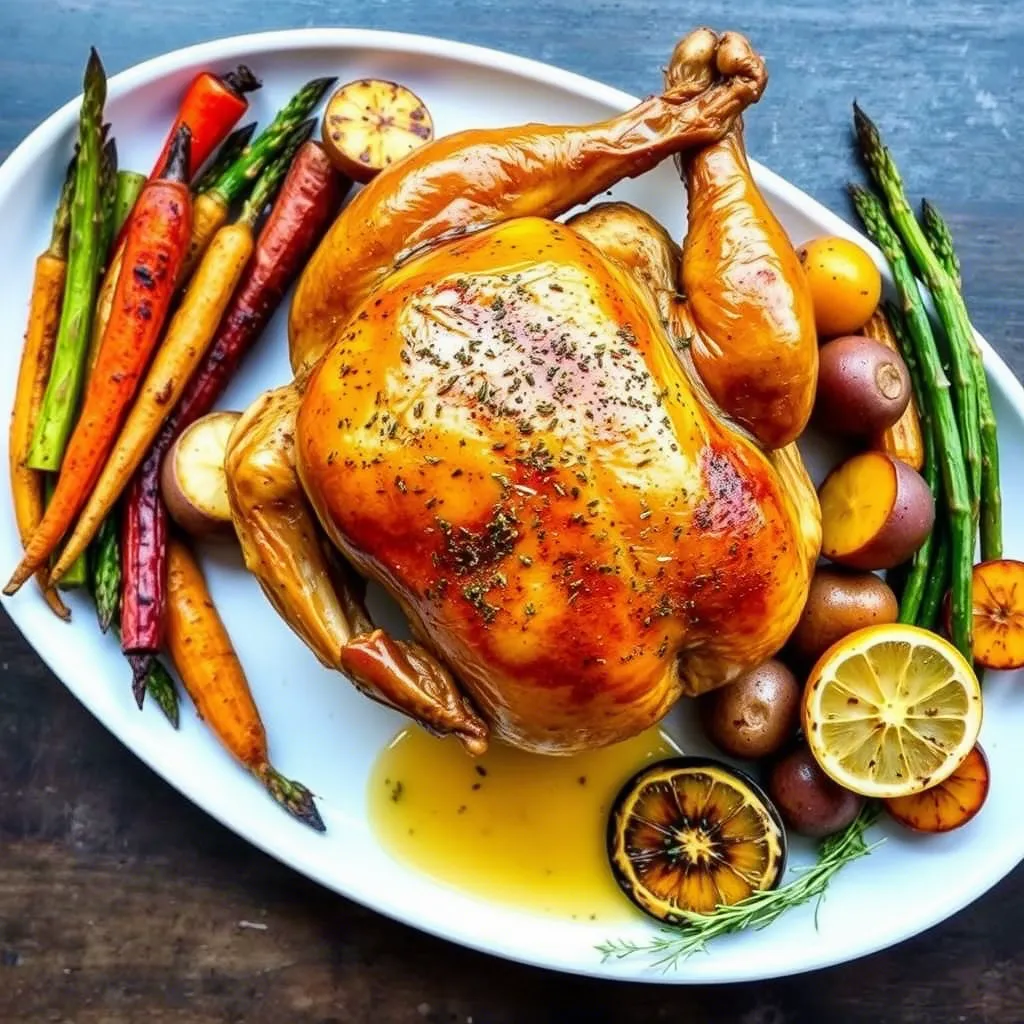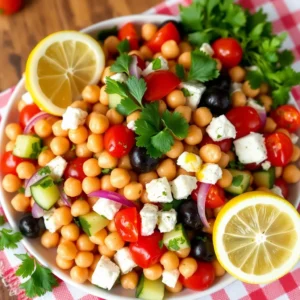Why You’ll Love This Lemon Herb Roasted Chicken
There’s something magical about a perfectly roasted chicken that fills your home with that irresistible aroma of herbs and citrus. This Lemon Herb Roasted Chicken with Spring Vegetables isn’t just another chicken recipe – it’s the answer to that “what’s for dinner?” question that haunts us all around 4 PM on a busy weekday. As a busy parent myself, I know the struggle of wanting to put something wholesome and impressive on the table without spending hours in the kitchen or dirtying every dish you own.
What makes this roasted chicken truly special is how it transforms simple ingredients into something that looks and tastes like you spent all day in the kitchen, when in reality, it’s mostly hands-off cooking time. The bright notes of lemon cut through the richness of the chicken, while the herbs create a fragrant crust that will have everyone at the table asking for seconds before they’ve finished their firsts.
For my fellow busy moms juggling work meetings, soccer practice, and the eternal mountain of laundry – this recipe is your new secret weapon. The prep work takes just 20 minutes, and then your oven does all the heavy lifting. While the chicken roasts to golden perfection, you can help with homework, catch up on emails, or (let’s be real) hide in the bathroom for five minutes of peace and quiet with your phone.
What I love most about this recipe is its flexibility. Having one of those days where the grocery store trip didn’t happen? No problem. This dish forgives substitutions and works with whatever spring vegetables you have on hand. The chicken and vegetables roast together in one pan, creating a complete meal with minimal cleanup – because the last thing any of us needs is more dishes to wash at 8 PM.
The combination of lemon and herbs isn’t just delicious; it’s also a breath of fresh air after heavy winter comfort foods. As the days get longer and we start craving lighter, brighter flavors, this roasted chicken delivers that spring energy we’re all desperately seeking after months of stews and casseroles.
And let’s talk about those roasted spring vegetables! They soak up all the wonderful chicken juices and get caramelized around the edges – even vegetable skeptics will be reaching for seconds. If you’ve been trying to incorporate more veggies into your family’s diet (without the dinnertime drama), this recipe is a painless way to do it. For more vegetable-forward recipes that will please even the pickiest eaters, check out my Roasted Stuffed Bell Peppers that follow the same principle of letting the oven do the work.
The Story Behind This Lemon Herb Roasted Chicken
Every family has those recipes that become more than just food – they’re tradition, comfort, and love all rolled into one delicious package. This Lemon Herb Roasted Chicken is one of those recipes in my home. It started as a happy accident on a Sunday afternoon when unexpected company was coming over, and I had little more than a whole chicken and some produce drawer remnants to work with.
I was in a complete tizzy, as my grandmother would say. There I was, hair up in what can only be described as a “panic bun,” frantically searching through the refrigerator like it might suddenly produce a catered meal if I opened and closed the door enough times. The chicken was there, some sad-looking lemons were rolling around the produce drawer, and my herb garden outside was really the only thing thriving in my life at that moment.
Sometimes the best recipes come from these moments of culinary desperation, don’t they? I remember thinking, “Well, when in doubt, add butter, lemon, and herbs to anything.” Words to live by, if you ask me.
What happened next was nothing short of a small kitchen miracle. That simple, thrown-together meal ended up being the highlight of the evening. My guests asked for the recipe, assuming I had been planning this culinary masterpiece all along. Little did they know I had been stress-sweating in the kitchen just hours before, wondering if cereal would be an acceptable dinner option for guests.
Since that fateful Sunday, this roasted chicken has made appearances at countless family dinners, holiday meals, and those nights when we just need something reliable and comforting. My kids now request it weekly, with my youngest calling it “sunny chicken” because of the bright lemon flavor that comes through in every bite.
There’s something deeply satisfying about placing a whole roasted chicken in the center of the table. It creates an instant feeling of abundance, of gathering, of home. In our world of quick meals eaten in shifts between activities, taking the time to roast a chicken feels almost rebellious – a statement that says, “We’re sitting down together for this one.”
What I love most about sharing this recipe with you is knowing that it might become part of your family’s story too. Perhaps it will save you on a night when unexpected guests arrive, or maybe it will become your Sunday tradition, filling your home with those mouthwatering aromas that say better than words ever could: dinner’s ready, and it’s going to be good.
The beauty of this recipe isn’t just in its flavors but in its simplicity. It doesn’t demand professional cooking skills or exotic ingredients. It just needs your hands to prepare it and your oven to transform it. And in that transformation lies the magic that turns a simple chicken into a meal worth remembering, worth sharing, worth coming home for.
Ingredients
Let’s gather everything we need for our Lemon Herb Roasted Chicken with Spring Vegetables. The beauty of this recipe lies in its straightforward ingredients list – nothing fancy or hard to find, just good, honest ingredients that work together to create something spectacular.
For the star of the show, you’ll need:
- 1 whole chicken (about 4-5 pounds) – Look for a plump bird with intact skin. If you can spring for an organic or free-range chicken, the flavor difference is noticeable, but a regular supermarket chicken works beautifully too.
- 3 tablespoons unsalted butter, softened – The butter creates that irresistible golden skin and helps the herbs stick. If you forget to soften it, just place it between two pieces of parchment and give it a few whacks with a rolling pin. Instant stress relief and softened butter in one go!
- 2 lemons – We’ll use both the zest and juice, so give them a good wash. Choose lemons that feel heavy for their size and have bright, fragrant skin.
- 4 cloves garlic, minced – Feel free to add more if you’re a garlic enthusiast like me. As my grandmother used to say, “Measure garlic with your heart, not with a spoon.”
- 2 tablespoons fresh rosemary, chopped – Woody herbs like rosemary stand up beautifully to roasting.
- 2 tablespoons fresh thyme leaves – Those tiny leaves pack a punch of flavor.
- 1 tablespoon fresh sage, chopped – Sage adds a wonderful earthiness that complements chicken perfectly.
- 2 tablespoons olive oil – Use a good quality one since you’ll taste it in the finished dish.
- Salt and freshly ground black pepper – Don’t be shy here! Proper seasoning makes all the difference.
For the spring vegetables:
- 1 pound baby potatoes, halved – These little gems get crispy on the outside and creamy inside when roasted. If you can find a rainbow mix, they’ll add beautiful color to your dish.
- 1 bunch asparagus, woody ends trimmed – Nothing says spring quite like asparagus. Choose stalks that are neither too thick nor too thin for ideal roasting.
- 2 cups baby carrots, or 4 regular carrots cut into sticks – Their natural sweetness intensifies when roasted.
- 1 large red onion, cut into wedges – The onion caramelizes in the oven, adding depth to our vegetable medley.
- 1 cup fresh or frozen peas – Add these in the last 10 minutes of cooking for a pop of sweetness and color.
- 2 tablespoons olive oil – For tossing the vegetables before roasting.
- Salt and pepper to taste – Always season your vegetables separately from the meat.
Optional ingredients that elevate this dish:
- 1/4 cup white wine – For deglazing the pan and creating a quick sauce.
- A handful of fresh parsley for garnish – That bright green finish makes everything look more appetizing.
- Lemon wedges for serving – The extra hit of fresh acidity at the table brightens everything up.
If your pantry’s looking a bit bare or you need to make substitutions, don’t worry! This recipe is incredibly forgiving. Don’t have fresh herbs? Dried will work in a pinch (use about 1/3 the amount). No lemons? Orange works wonderfully too, creating a slightly sweeter profile. Vegetable options are endless – green beans, brussels sprouts, or fennel would all be delicious additions or substitutions based on what’s in season or what your family prefers.
For the vegetable skeptics in your family, you might find some helpful tips in my Amazing Caesar Salad article, where I share some tried-and-true methods for making vegetables more appealing to reluctant eaters. According to research from Food and Nutrition Research, roasting vegetables significantly increases their palatability, especially for children, thanks to the caramelization process that brings out natural sweetness.
Execution
Now that we’ve got all our ingredients ready, let’s walk through the cooking process step by step. Don’t worry – there’s nothing complicated here, just simple techniques that yield impressive results.
- Prepare the chicken and flavored butter (10 minutes): First things first – preheat your oven to 425°F (220°C). A hot oven is crucial for that golden, crispy skin we’re after. Take your chicken out of the refrigerator about 30 minutes before cooking to take the chill off. This helps it cook more evenly.In a small bowl, combine the softened butter with the zest of one lemon, half of the minced garlic, and half of the chopped herbs. Season this mixture with a generous pinch of salt and pepper. Mix until well combined – this herb butter is going to be our flavor bomb.Pat the chicken dry with paper towels – really dry, like you’re giving it a spa treatment. A dry bird equals crispy skin, and crispy skin equals happiness. Season the cavity generously with salt and pepper.
- Season the chicken (5 minutes): Cut one lemon into quarters and stuff it into the cavity of the chicken along with a few sprigs of the remaining herbs and the rest of the garlic. This will infuse the meat from the inside as it cooks.Now for the fun part – gently separate the skin from the breast meat using your fingers, being careful not to tear it. Spread about two-thirds of your herb butter mixture under the skin, directly on the meat. This keeps the breast meat juicy while flavoring it from within.Rub the remaining herb butter all over the outside of the chicken. Then drizzle the olive oil over the bird and give it another generous sprinkle of salt and pepper. Tie the legs together with kitchen twine if you have it, or simply tuck the wing tips under the body. This helps the chicken cook evenly.
- Prepare the vegetables (5 minutes): In a large roasting pan or cast-iron skillet, toss the potatoes, carrots, and onion wedges with olive oil, salt, and pepper. Arrange them around the edges of the pan, leaving space in the center for our chicken.Place the prepared chicken in the center of the pan, breast-side up, surrounded by the vegetables. The vegetables will absorb all those wonderful juices as the chicken cooks – nature’s basting system at its finest!
- Roasting process (50 minutes): Slide your masterpiece into the preheated oven. For the first 20 minutes, roast at the high heat of 425°F (220°C) to get that skin crisping up nicely. Then, without opening the oven door, reduce the temperature to 375°F (190°C) and continue roasting for about 30 minutes more.After 30 minutes, add the asparagus to the pan, giving them a quick toss in the pan juices. Continue roasting until the chicken is golden brown and the juices run clear when you pierce the thickest part of the thigh, or until a meat thermometer inserted into the thigh (without touching bone) reads 165°F (74°C).If you notice the skin browning too quickly, simply tent the chicken loosely with foil – no drama needed!
- Final touches (10 minutes): Remove the pan from the oven and transfer the chicken to a cutting board. Let it rest for at least 10 minutes before carving. This step is crucial – it allows the juices to redistribute throughout the meat, ensuring it stays moist when carved.While the chicken is resting, add the peas to the hot pan with the other vegetables and toss them together. The residual heat will cook the peas perfectly. Squeeze the juice from the remaining lemon over the vegetables and toss again.For an optional but delicious pan sauce, place the roasting pan over medium heat on the stovetop (if using a stovetop-safe pan). Add the white wine and scrape up any browned bits from the bottom of the pan with a wooden spoon. Let it simmer for a minute or two until slightly reduced, then spoon this liquid gold over the carved chicken.
- Serving (5 minutes): Carve the chicken into portions and arrange on a platter with the roasted vegetables all around. Sprinkle with fresh parsley and serve with lemon wedges on the side for those who want an extra citrus kick.As you place this beautiful creation on your table, take a moment to appreciate what you’ve made – a complete, nutritious, and absolutely gorgeous meal that’s worthy of a special occasion but simple enough for a Tuesday night.
Additional Tips
The beauty of a recipe like this Lemon Herb Roasted Chicken lies not just in its delicious outcome, but in how adaptable it can be to your specific needs and preferences. Let me share some of my favorite tips and variations that will help you make this dish truly your own, whether you’re cooking for a special occasion or just trying to get dinner on the table after a long day.
For the perfectly roasted chicken:
- Temperature is key. Invest in an instant-read thermometer if you don’t already own one. It takes the guesswork out of knowing when your chicken is perfectly done at 165°F (74°C) in the thickest part of the thigh.
- If your chicken is larger than 5 pounds, add about 10 minutes of cooking time per additional pound. A good rule of thumb is 20 minutes per pound at 375°F (190°C).
- Don’t skip the resting period! Those 10 minutes might seem like an eternity when you’re hungry, but they make all the difference between juicy chicken and dry disappointment.
- For extra crispy skin, pat the chicken dry and then leave it uncovered in the refrigerator for a few hours or overnight before cooking. This dries out the skin, which helps it crisp up beautifully.
Seasonal variations to try:
- Summer: Swap spring vegetables for cherry tomatoes, zucchini, and bell peppers. Add some fresh basil in the last few minutes of cooking.
- Fall: Try butternut squash, Brussels sprouts, and apples instead of spring vegetables. A sprinkle of cinnamon and sage makes it perfectly autumnal.
- Winter: Go for hearty root vegetables like parsnips, turnips, and celery root with rosemary and thyme.
For busy weeknights:
- Prep ahead! You can season the chicken and chop all vegetables the night before. Store everything separately in the refrigerator, then just assemble and pop in the oven when you get home.
- Turn leftovers into another meal. Shred leftover chicken for tacos, salads, or sandwiches. Even the carcass can be simmered for homemade stock – talk about getting your money’s worth!
- No time to roast a whole chicken? This same herb and lemon treatment works beautifully on chicken thighs or breasts, with cooking time reduced to about 25-35 minutes.
For special occasions:
- Double the herb butter recipe and serve some on the side for spreading on warm dinner rolls. It’s those little extras that make guests feel special.
- Create a more dramatic presentation by placing the whole roasted chicken on a bed of fresh herbs before bringing it to the table.
- For holiday gatherings, add a handful of dried cranberries to the vegetables in the last 5 minutes of cooking for a festive pop of color and sweetness.
Troubleshooting common issues:
- If your vegetables are done before your chicken, simply remove them from the pan and continue cooking the chicken.
- Chicken skin not crispy enough? Run it under the broiler for 2-3 minutes, watching carefully to avoid burning.
- If your chicken is browning too quickly but isn’t cooked through, tent it with foil to prevent the skin from burning while the meat finishes cooking.
Storage and reheating:
- Leftover chicken will keep in the refrigerator for up to 3 days when stored in an airtight container.
- For best results when reheating, sprinkle a little water or chicken broth over the meat before covering and warming in a 325°F (165°C) oven until heated through.
- Freeze shredded leftover chicken in portion-sized containers for up to 3 months. It’s perfect for adding to soups and casseroles later.
Making it kid-friendly:
- If your little ones aren’t fans of herbs “floating” in their food, strain some of the pan juices and serve as a dipping sauce on the side.
- Let kids help with the preparation! Even young children can help wash vegetables or sprinkle herbs. As the experts at The American Academy of Pediatrics confirm, involving children in meal preparation increases the likelihood they’ll try new foods.
- For picky eaters, try cutting vegetables into fun shapes or serving them separated on the plate rather than mixed together.
This recipe has saved my dinner plans countless times, and it continues to evolve in my kitchen. For more easy but impressive chicken recipes, check out my 7 Delicious Secrets to Perfect Chicken Breasts – another foolproof option for those nights when you need dinner to be a guaranteed success.
FAQs
Can I use dried herbs instead of fresh ones? Absolutely! While fresh herbs provide the brightest flavor, dried herbs work wonderfully too. The general rule is to use one-third the amount of dried herbs compared to fresh. So for this recipe, use about 2 teaspoons each of dried rosemary and thyme, and 1 teaspoon of dried sage. Add them to the butter mixture just as you would the fresh herbs. The flavors might be slightly more concentrated, which isn’t a bad thing at all!
How do I know when the chicken is fully cooked? The most reliable method is using an instant-read thermometer inserted into the thickest part of the thigh (without touching the bone), which should read 165°F (74°C). If you don’t have a thermometer, pierce the thigh with a knife – the juices should run clear with no pinkness. The leg should also move freely in its socket when wiggled. Remember that carryover cooking will continue to raise the temperature slightly during the resting period.
What can I do if I don’t have a roasting pan large enough for both the chicken and vegetables? No problem! You can roast the chicken in one dish and the vegetables in another. Place the chicken on a rack in a roasting pan or in a cast-iron skillet. Roast the vegetables separately on a rimmed baking sheet. The vegetables might cook faster than the chicken, so check them earlier. You won’t get the benefit of the vegetables cooking in the chicken juices, but you can drizzle some of the pan juices over the vegetables before serving.
Can I prepare this dish ahead of time for a dinner party? This herb roasted chicken is perfect for entertaining because so much can be done ahead. You can prepare the herb butter and season the chicken up to 24 hours in advance, keeping it covered in the refrigerator. Prep all your vegetables and store them in water in the refrigerator to prevent drying out. About 30 minutes before you’re ready to start cooking, take the chicken out of the refrigerator to take the chill off. Drain and dry your prepped vegetables, and proceed with the recipe as written.
What’s the best way to carve a whole chicken? Carving a chicken can seem intimidating, but it’s actually quite straightforward:
- Start by removing the legs and thighs. Cut through the skin between the body and the thigh, then bend the leg back until the joint pops. Cut through the joint to separate.
- For the wings, pull each wing away from the body and cut through the joint.
- To remove the breasts, cut along each side of the breastbone, then angle your knife and follow the rib cage to remove each breast in one piece. Slice the breast meat across the grain for tender portions.
- Don’t forget that the oysters – those two small, round pieces of dark meat on the chicken’s back – are often considered the most flavorful bites!
Can I use this recipe for other poultry like turkey or Cornish game hens? This recipe adapts beautifully to other birds! For a turkey, you’ll need to scale up the quantities and increase the cooking time significantly (about 15 minutes per pound at 325°F/165°C). For Cornish game hens, reduce the cooking time to about 45-50 minutes total, and consider reducing the oven temperature to 375°F (190°C) for the entire cooking time to prevent them from drying out.
I’m trying to reduce calories – can I make this dish lighter? While the butter adds wonderful richness, you can create a lighter version by replacing all or part of the butter with additional olive oil. You’ll still get crispy skin and great flavor. You could also remove the skin after cooking to reduce fat content, though you’ll miss out on that crispy goodness! Increasing the ratio of vegetables to chicken is another great way to create a lighter meal while still enjoying all those wonderful flavors.
A perfectly roasted chicken with spring vegetables is more than just a meal – it’s a celebration of simple ingredients transformed through heat and time into something truly special. This Lemon Herb Roasted Chicken has been my reliable dinner companion through busy weeknights and special gatherings alike, and I hope it brings the same joy to your table. There’s something deeply satisfying about placing a golden, fragrant roasted chicken at the center of your table, surrounded by colorful vegetables and eager faces. It’s a reminder that sometimes the most straightforward cooking methods yield the most impressive results.
As with all cooking, the real magic happens when you make this recipe your own. Trust your instincts, adapt to what’s available in your pantry, and remember that a little imperfection is part of the charm of home cooking. Your family won’t remember if the skin was perfectly crisp or if you forgot to add the peas – they’ll remember the warmth, the aroma, and the care that went into creating a meal meant for sharing.



